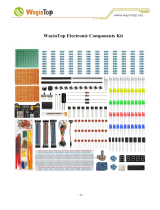Page is loading ...

USER MANUAL
EN
DS1302 real-time clock module
WPI301
whadda.com

2
Introduction
To all residents of the European Union
Important environmental information about this product
This symbol on the device or the package indicates that disposal of the device after its
lifecycle could harm the environment. Do not dispose of the unit (or batteries) as unsorted
municipal waste; it should be taken to a specialized company for recycling. This device
should be returned to your distributor or to a local recycling service. Respect the local
environmental rules.
If in doubt, contact your local waste disposal authorities.
Thank you for choosing Whadda! Please read the manual thoroughly before bringing this
device into service. If the device was damaged in transit, do not install or use it and contact
your dealer.
Safety Instructions
Read and understand this manual and all safety signs before using this appliance.
For indoor use only.
• This device can be used by children aged from 8 years and above, and persons with
reduced physical, sensory or mental capabilities or lack of experience and knowledge if
they have been given supervision or instruction concerning the use of the device in a
safe way and understand the hazards involved. Children shall not play with the device.
Cleaning and user maintenance shall not be made by children without supervision.
General Guidelines
• Refer to the Velleman® Service and Quality Warranty on the last pages of this manual.
• All modifications of the device are forbidden for safety reasons. Damage caused by
user modifications to the device is not covered by the warranty.
• Only use the device for its intended purpose. Using the device in an unauthorized way
will void the warranty.
• Damage caused by disregard of certain guidelines in this manual is not covered by the
warranty and the dealer will not accept responsibility for any ensuing defects or
problems.
• Nor Velleman Group nv nor its dealers can be held responsible for any damage
(extraordinary, incidental or indirect) – of any nature (financial, physical…) arising from
the possession, use or failure of this product.
• Keep this manual for future reference.

3
What is Arduino®
Arduino® is an open-source prototyping platform based on easy-to-use hardware and
software. Arduino® boards are able to read inputs – light-on sensor, a finger on a button or a
Twitter message – and turn it into an output – activating of a motor, turning on an LED,
publishing something online. You can tell your board what to do by sending a set of
instructions to the microcontroller on the board. To do so, you use the Arduino
programming language (based on Wiring) and the Arduino® software IDE (based on
Processing). Additional shields/modules/components are required for reading a twitter
message or publishing online. Surf to www.arduino.cc for more information.
Product Overview
The DS1302 trickle-charge timekeeping chip contains a real-time clock/calendar and 31
bytes of static RAM. It communicates with a microprocessor via a simple serial interface.
The real-time clock/calendar provides seconds, minutes, hours, day, date, month, and year
information. The end of the month date is automatically adjusted for months with fewer
than 31 days, including corrections for leap year. The clock operates in either the 24-hour
or 12-hour format with an AM/PM indicator.
Specifications
• power supply: 1 x CR2032 (included)
• TTL compatible: VCC = 5 V
• temperature range: 0 °C to +70 °C
Features
• manages all timekeeping functions: real-time clock counts seconds, minutes, hours,
date of the month, month, day of the week, and year with leap year
• 31 x 8 battery-backed general-purpose RAM
• simple serial port interfaces to most microcontrollers: simple 3-wire interface
• single-byte or multiple-byte (burst mode) data transfer for read or write of clock or
RAM data
• low power operation extends battery backup run time: 2.0 V to 5.5 V full operation
• uses less than 300 µA @ 2.0 V

4
Connection
Arduino®
WPI301
D5
CE
D6
I/O
D7
SCLK
5 V
VCC
GND
GND
Pin Layout
CE
Input. The CE signal must be asserted high during a read or a write. This pin has
an internal 40 kΩ (typ) pulldown resistor to ground. Note: Previous data sheet
revisions referred to CE as RST. The functionality of the pin has not changed.
I/O
Input/push-pull output. The I/O pin is the bidirectional data pin for the 3-wire
interface. This pin has an internal 40 kΩ (typ) pulldown resistor to ground.
SCLK
Input. SCLK is used to synchronize data movement on the serial interface. This
pin has an internal 40 kΩ (typ) pulldown resistor to ground.

5
VCC
Primary power supply pin in dual supply configuration. VCC1 is connected to a
backup source to maintain the time and date in the absence of primary power.
The VMA301 operates from the larger of VCC1 or VCC2. When VCC2 is greater
than VCC1 + 0.2 V, VCC2 powers the WPI301. When VCC2 is less than VCC1, VCC1
powers the WPI301.
GND
Ground.
Example
Before being able to use the sample program, an additional library needs to be installed. Go
to Sketch > Include Library > Manage Libraries...
Put "DS1302" in the search bar and install the RTC library by Makuna (should be the first
result).

6
Whadda WPI301 DS1302 Real-time clock module example
This demo sets the time on the DS1302 RTC module to the compiled time of the sketch.
After this is configured the time returned by the DS1302 module is periodically printed on
the serial monitor
Check whadda.com for more information including a wiring diagram for this demo.
// CONNECTIONS:
// DS1302 CLK/SCLK --> 7
// DS1302 DAT/IO --> 6
// DS1302 RST/CE --> 5
// DS1302 VCC --> 3.3v - 5v
// DS1302 GND --> GND
*/
#include <ThreeWire.h>
#include <RtcDS1302.h>
ThreeWire myWire(6,7,5); // IO, SCLK, CE
RtcDS1302<ThreeWire> Rtc(myWire);
void setup ()
{
Serial.begin(57600);
Serial.print("compiled: ");
Serial.print(__DATE__);
Serial.println(__TIME__);
Rtc.Begin();
RtcDateTime compiled = RtcDateTime(__DATE__, __TIME__);
printDateTime(compiled);
Serial.println();
//Rtc.SetDateTime(compiled);
if (!Rtc.IsDateTimeValid())
{
// Common Causes:
// 1) first time you ran and the device wasn't running yet
// 2) the battery on the device is low or even missing
Serial.println("RTC lost confidence in the DateTime!");
Rtc.SetDateTime(compiled);
}
if (Rtc.GetIsWriteProtected())
{
Serial.println("RTC was write protected, enabling writing now");

7
Rtc.SetIsWriteProtected(false);
}
if (!Rtc.GetIsRunning())
{
Serial.println("RTC was not actively running, starting now");
Rtc.SetIsRunning(true);
}
RtcDateTime now = Rtc.GetDateTime();
if (now < compiled)
{
Serial.println("RTC is older than compile time! (Updating DateTime)");
Rtc.SetDateTime(compiled);
}
else if (now > compiled)
{
Serial.println("RTC is newer than compile time. (this is expected)");
}
else if (now == compiled)
{
Serial.println("RTC is the same as compile time! (not expected but all is fine)");
}
}
void loop ()
{
RtcDateTime now = Rtc.GetDateTime();
printDateTime(now);
Serial.println();
if (!now.IsValid())
{
// Common Causes:
// 1) the battery on the device is low or even missing and the power line was
disconnected
Serial.println("RTC lost confidence in the DateTime!");
}
delay(10000); // ten seconds
}
#define countof(a) (sizeof(a) / sizeof(a[0]))
void printDateTime(const RtcDateTime& dt)
{
char datestring[20];

8
snprintf_P(datestring,
countof(datestring),
PSTR("%02u/%02u/%04u %02u:%02u:%02u"),
dt.Month(),
dt.Day(),
dt.Year(),
dt.Hour(),
dt.Minute(),
dt.Second() );
Serial.print(datestring);
}

9
whadda.com
Modifications and typographical errors reserved - © Velleman Group nv. WPI301_v01
Velleman Group nv, Legen Heirweg 33 - 9890 Gavere.
/



